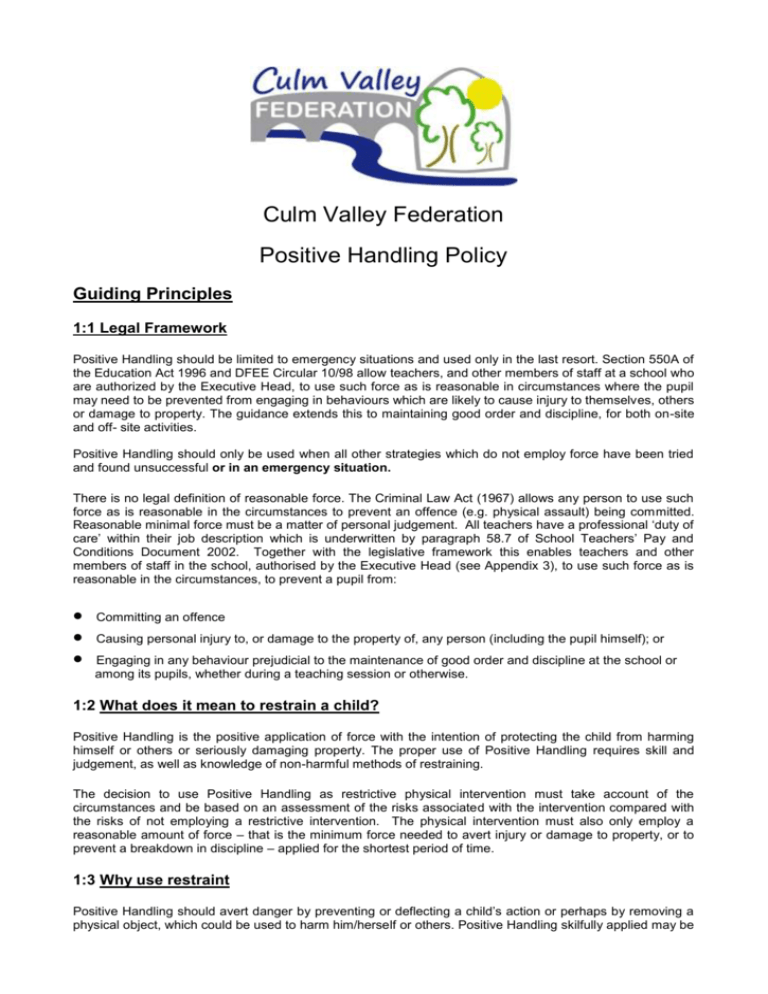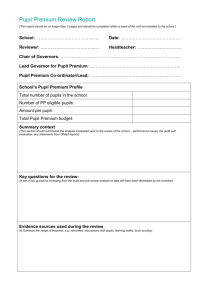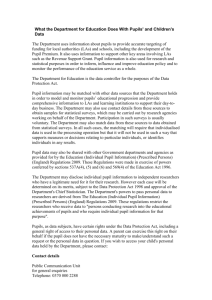Positive Handling policy - Culmstock Primary School
advertisement

Culm Valley Federation Positive Handling Policy Guiding Principles 1:1 Legal Framework Positive Handling should be limited to emergency situations and used only in the last resort. Section 550A of the Education Act 1996 and DFEE Circular 10/98 allow teachers, and other members of staff at a school who are authorized by the Executive Head, to use such force as is reasonable in circumstances where the pupil may need to be prevented from engaging in behaviours which are likely to cause injury to themselves, others or damage to property. The guidance extends this to maintaining good order and discipline, for both on-site and off- site activities. Positive Handling should only be used when all other strategies which do not employ force have been tried and found unsuccessful or in an emergency situation. There is no legal definition of reasonable force. The Criminal Law Act (1967) allows any person to use such force as is reasonable in the circumstances to prevent an offence (e.g. physical assault) being committed. Reasonable minimal force must be a matter of personal judgement. All teachers have a professional ‘duty of care’ within their job description which is underwritten by paragraph 58.7 of School Teachers’ Pay and Conditions Document 2002. Together with the legislative framework this enables teachers and other members of staff in the school, authorised by the Executive Head (see Appendix 3), to use such force as is reasonable in the circumstances, to prevent a pupil from: Committing an offence Causing personal injury to, or damage to the property of, any person (including the pupil himself); or Engaging in any behaviour prejudicial to the maintenance of good order and discipline at the school or among its pupils, whether during a teaching session or otherwise. 1:2 What does it mean to restrain a child? Positive Handling is the positive application of force with the intention of protecting the child from harming himself or others or seriously damaging property. The proper use of Positive Handling requires skill and judgement, as well as knowledge of non-harmful methods of restraining. The decision to use Positive Handling as restrictive physical intervention must take account of the circumstances and be based on an assessment of the risks associated with the intervention compared with the risks of not employing a restrictive intervention. The physical intervention must also only employ a reasonable amount of force – that is the minimum force needed to avert injury or damage to property, or to prevent a breakdown in discipline – applied for the shortest period of time. 1:3 Why use restraint Positive Handling should avert danger by preventing or deflecting a child’s action or perhaps by removing a physical object, which could be used to harm him/herself or others. Positive Handling skilfully applied may be eased by degrees as the child calms down in response to the physical contact. It is only likely to be needed if a child appears to be unable to exercise self-control of emotions and behaviour. 2:1 General aims The staff in Culm Valley Federation recognise that the use of reasonable force is only one of the strategies available to secure pupil safety/well-being and also to maintain good order and discipline, and should only be used as a last resort. Our policy on the use of reasonable force is part of our overall pastoral care procedures and closely related to our policies on managing pupil behaviour in the "Behaviour and Discipline Policy" and also to the County’s "Child Protection Guidelines". 2:2 The aims. To protect every person in the school community from harm. To protect all pupils against any form of physical intervention which is unnecessary, inappropriate, excessive or harmful. To provide adequate information and training for staff so that they are clear as to what constitutes appropriate behaviour and to deal effectively with violent or potentially violent situations. To use the minimum degree of force necessary to accomplish positive handling. To give full support to staff who have been assaulted or have suffered verbal abuse from pupils or others. To maintain accurate records of incidents where Positive Handling has been employed. 2:3 When might it be appropriate to use reasonable force? 1. Committing an offence 2. Causing personal injury to, or damage to the property of, any person (including the pupil himself); or 3. Engaging in any behaviour prejudicial to the maintenance of good order and discipline at the school or amongst it’s pupils, whether during a teaching session or otherwise. Examples of situations that fall into one of the first two categories are A pupil attacks a member of staff, or another pupil; Pupils fighting; A pupil is causing, or at risk of causing, injury or damage by accident, by rough play, or by misuse of dangerous materials, substances or objects; A pupil is running in a corridor or on a stairway in a way in which he/she might have or cause an accident likely to injure her/himself or others; A pupil absconds from a class or tries to leave school (NB this will only apply if a pupil could be at risk if not kept in the classroom or at school). Examples of situations that fall into the third category are: A pupil persistently refuses to obey an order to leave a classroom. A pupil is behaving in such a way that is seriously disrupting a lesson. 3:1 Risk Assessment Although most young people in Culm Valley Federation will never require any form of Positive Handling, staff may have to deal with some young people who exhibit disturbed, distressed and distressing behaviour. It is therefore necessary to carry out risk assessment. We will attempt to reduce risk by managing: The environment Body language The way we talk The way we act 3:2 Environmental Risk Assessment We will complete a risk analysis within the school and put in place strategies to minimise these risks in identified locations. 3:3 Individual Risk Assessments The school’s respect for the rights of the individual takes into consideration the context of The Human Rights Act (1998) and The United Nations Convention on the Rights of the Child (1991). The school’s ethos and the guidance in this policy is based on the presumption that every adult and child is entitled to: Respect for his/her private life The right not to be subjected to inhuman or degrading treatment The right to liberty and security: and The right not to be discriminated against in his/her enjoyment of those rights. If we become aware that a pupil is likely to behave in a disruptive way that may require the use of reasonable force, it is our intention to plan how to respond if the situation arises. Such planning needs to address: Managing the pupil (e.g. reactive strategies to de-escalate a conflict, holds to be used if necessary); Involving the parents to ensure that they are clear about the specific action the school might need to take; Briefing staff to ensure they know exactly what action they should be taking (this may identify a need for training or guidance); Ensuring that additional support can be summoned if appropriate. If Positive Handling is likely to be necessary this should be included in the pupil’s Individual Education Plan (IEP) together with information on: de-escalation strategies; the manner in which the pupil will be held; how support can be summoned if needed; any medical factors to be considered. More detailed examples of risk assessment and preventative steps can be found in Appendix 1. 4:1 Procedures In the event of Positive Handling having been used it is important to consider the strategies, which are deemed acceptable, and the recording procedures that should be in place. 4:2 Action Steps: 1. Tell the pupil who is misbehaving to stop and state possible consequences of failure to do so; 2. If possible summon another adult; 3. Continue to communicate with the pupil throughout the incident; 4. Make it clear that restraint will be removed as soon as it ceases to be necessary; 5. Appropriate follow-up action should be taken, which may include: i. Providing medical support ii. Providing respite for those involved * A calm and measured approach to a situation is needed and staff should never give the impression that they have lost their temper or are acting out of anger or frustration when handling a problem. * 4:3 Recording Staff should record (Appendix 3) all incidents of restraint in accordance with School Policy and report these to the Executive Head, as soon as is practicable Details should include: Name of pupil(s) Staff member(s) involved Factors necessitating physical intervention The strategies which were employed prior to using physical intervention How physical intervention was effected Outcome of restraint Any other action taken in the management of the incident Parents/carers should be contacted as soon as possible and the incident explained to them. This action should also be recorded. 4:4 Training It is the responsibility of the Executive Head to ensure that staff are fully informed of the school policy and understand what authorisation entails. (ii) It is the responsibility of the Executive Head to arrange training or guidance to staff, possibly through a senior member of staff or through advice from outside agencies. (iii) There are no government approved training techniques for Positive Handling. The Executive Head may wish to consult with the Local Education Authority if any particular course of training is to be embarked upon. (iv) Additional advice and support on managing behaviour can be provided through the Educational Psychology Service or Behaviour Support Service. 5:1 Complaints We all have a duty of care to the young people in our school and cannot escape our legal responsibilities by avoiding taking appropriate and necessary action. Involving parents when an incident occurs with their child, together with a clear policy adhered to by the staff, should help to avoid complaints from parents. It will not prevent all complaints, however, and a dispute about the use of force by a member of staff might lead to an investigation, either under disciplinary procedures or by the Police and social services department under child protection procedures. Staff, subjected to physical violence or assault, have the right to be supported in making a formal complaint to the police and, if necessary, taking private action against an assailant. 6:1 Communication It is our intention to inform all staff, pupils, parents and governors about these procedures and the context in which they apply. We will review this policy on a four-yearly basis, or when legislation is revised. Remember that adhering to the principles and procedures referred to in this policy statement is part of effective practice and should minimise risk to young people in our care and enhance our own self-protection. 7:1 Review of the Policy This policy will be reviewed every X3 years by the Governing Body, or when legislation is revised. Agreed by Staff: Adopted by Governors: Review Date: Appendix 1: Strategies All teachers need to be aware of strategies and techniques for dealing with difficult pupils and steps, which they can take to defuse and calm a situation. Move calmly and confidently. Make simple, clear statements. Intervene early. Try to maintain eye contact. If necessary summon help before the problem escalates. Remove audience from the immediate location. There are situations where staff should not intervene without help: Assistance should be sought when dealing with: A physically large pupil, More than one pupil, or When the teacher believes that s/he may be at risk of injury. In those circumstances where the member of staff has decided that it is not appropriate to restrain the pupil without help they should: Remove other pupils who might be at risk, Summon assistance from colleagues, Where necessary, telephone the police, Inform the pupil(s) that help will be arriving, Until assistance arrives, the member of staff should continue to attempt to defuse the situation orally, and try to prevent the incident from escalating. The method of restraint employed must use the minimum force for the minimum time and must observe the following requirements: DfEE Circular 10/98 gives examples where reasonable force might be necessary to control or restrain pupils and attention of staff is drawn to the list of actions in paragraphs 23 and 24 of the Circular which would normally be considered unjustifiable. In any event Restraint must NOT: o o o o Involve hitting the pupil; Involve deliberately inflicting pain on the pupil; Restrict the pupil’s breathing; Involve contact with sexually sensitive areas. During any incident the restrainer should: o o o Offer verbal reassurance to the pupil; Cause the minimum level of restriction of movement; Reduce the danger of any accidental injury. Physical intervention can take several forms. It might involve staff: o o o o o o o o Physically interposing between pupils; Blocking a pupil’s path; Holding; Pushing; Pulling; Leading a pupil by the hand or arm; Shepherding a pupil away by placing a hand in the centre of the back; or (In extreme circumstances) using more restrictive holds. Some Dos and Don’ts DO Be aware of any feelings of anger Summon help Continue to talk to the pupil in a calm way Provide a soft surface if possible Be aware of any accessories worn by you or the pupil Hold the pupil’s arms by his/her sides DON’T Try to manage on your own Stop talking even if the pupil does not reply Straddle the pupil Push arms up the back Touch the pupil near the throat or head Put pressure on joints Appendix 2: Reporting and Recording Proforma RECORD OF RESTRAINT Date of incident: Time of incident: Pupil Name: D.o.B: Member(s) of staff involved: Adult witnesses to restraint: Pupil witnesses to restraint: Outline of event leading to restraint – including other strategies tried and reasons for using Positive Handling rather than another strategy: Outline of incident of restraint (including restraint method used): Outcome of restraint: Description of any injury(ies) sustained by injured pupil and any subsequent treatment: Date parent/carer informed of incident: Time: By whom informed: Outline of parent/carer response: Signature of staff completing report: Date: Signature of Teacher-in-charge: Date: Signature of Executive Head: Date: Brief description of any subsequent inquiry/complaint or action: Appendix 3: Authorised Staff From section 550A of The Education Act 1996: 9. The Act allows all teachers at a school to use reasonable force to control or restrain pupils. It also allows other people to do so, in the same way as teachers, provided they have been authorised by the Head teacher to have control or charge of pupils. Those might include classroom assistants, care workers, midday supervisors, specialist support assistants, education welfare officers, escorts, caretakers, or voluntary helpers including people accompanying pupils on visits, exchanges or holidays organised by the school. 10. Head teachers should identify people, other than teachers, whom they wish to authorise to have control or charge of pupils and therefore be able to use force if necessary. Authorisation may be on a permanent or long term basis because of the nature of the person's job, or short term for a specific event such as a school trip. The Head should explicitly inform the people concerned, and ensure that they are aware of and properly understand what the authorisation entails. To ensure that, Heads may find it helpful to arrange for a senior member of the teaching staff to provide training or guidance. References used in drawing up this policy: The Human Rights Act (1998) DfEE Circular 10/98 Advice from the Devon Association of Primary Headteachers







